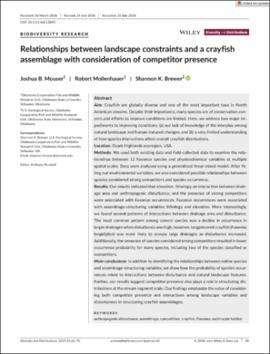| dc.contributor.author | Mouser, Joshua B. | |
| dc.contributor.author | Mollenhauer, Robert | |
| dc.contributor.author | Brewer, Shannon K. | |
| dc.date.accessioned | 2021-07-13T20:02:29Z | |
| dc.date.available | 2021-07-13T20:02:29Z | |
| dc.date.issued | 2019 | |
| dc.identifier | oksd_Mouser_relationshipsbetweenland_2018 | |
| dc.identifier.citation | Mouser, J. B., Mollenhauer, R., & Brewer, S. K. (2019). Relationships between landscape constraints and a crayfish assemblage with consideration of competitor presence, Diversity and Distributions, 25, 61-73. https://doi.org/10.1111/ddi.12840 | |
| dc.identifier.uri | https://hdl.handle.net/11244/330134 | |
| dc.description.abstract | Aim: Crayfish are globally diverse and one of the most important taxa in North American streams. Despite their importance, many species are of conservation concern and efforts to improve conditions are limited. Here, we address two major impediments to improving conditions: (a) our lack of knowledge of the interplay among natural landscape and human-induced changes; and (b) a very limited understanding of how species interactions affect overall crayfish distributions. | |
| dc.description.abstract | Location: Ozark Highlands ecoregion, USA. | |
| dc.description.abstract | Methods: We used both existing data and field-collected data to examine the relationships between 12 Faxonius species and physicochemical variables at multiple spatial scales. Data were analysed using a generalized linear mixed model. After fitting our environmental variables, we also considered possible relationships between species considered strong competitors and species occurrence. | |
| dc.description.abstract | Results: Our results indicated that elevation, lithology, an interaction between drainage area and anthropogenic disturbance, and the presence of strong competitors were associated with Faxonius occurrences. Faxonius occurrences were associated with assemblage-structuring variables: lithology and elevation. More interestingly, we found several patterns of interactions between drainage area and disturbance. The most common pattern among several species was a decline in occurrence in larger drainages when disturbance was high; however, longpincered crayfish (Faxonius longidigitus) was more likely to occupy large drainages as disturbance increased. Additionally, the presence of species considered strong competitors resulted in lower occurrence probability for many species, including two of the species classified as competitors. | |
| dc.description.abstract | Main conclusions: In addition to identifying the relationships between native species and assemblage-structuring variables, we show how the probability of species occurrences relate to interactions between disturbance and natural landscape features. Further, our results suggest competitor presence also plays a role in structuring distributions at the stream segment scale. Our findings emphasize the value of considering both competitor presence and interactions among landscape variables and disturbances in structuring crayfish assemblages. | |
| dc.format | application/pdf | |
| dc.language | en_US | |
| dc.publisher | John Wiley and Sons | |
| dc.relation | Data from: Relationships between landscape constraints and a crayfish assemblage with consideration of competitor presence | |
| dc.relation.uri | https://hdl.handle.net/11244/301819 | |
| dc.rights | This material has been previously published. In the Oklahoma State University Library's institutional repository this version is made available through the open access principles and the terms of agreement/consent between the author(s) and the publisher. The permission policy on the use, reproduction or distribution of the material falls under fair use for educational, scholarship, and research purposes. Contact Digital Resources and Discovery Services at lib-dls@okstate.edu or 405-744-9161 for further information. | |
| dc.title | Relationships between landscape constraints and a crayfish assemblage with consideration of competitor presence | |
| osu.filename | oksd_Mouser_relationshipsbetweenland_2018.pdf | |
| dc.description.peerreview | Peer reviewed | |
| dc.identifier.doi | 10.1111/ddi.12840 | |
| dc.description.department | Oklahoma Cooperative Fish and Wildlife Research Unit | |
| dc.type.genre | Article | |
| dc.type.material | Text | |
| dc.subject.keywords | anthropogenic disturbance | |
| dc.subject.keywords | assemblage | |
| dc.subject.keywords | competition | |
| dc.subject.keywords | crayfish | |
| dc.subject.keywords | faxonius | |
| dc.subject.keywords | multi-scale habitat | |
| osu.authorOrcid.uri | https://orcid.org/0000-0002-1537-3921 | |
